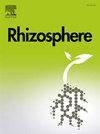Plant species shaping rhizosphere fungal community structure in the subalpine forest steppe belt
IF 3.4
3区 生物学
Q1 PLANT SCIENCES
引用次数: 0
Abstract
Rhizosphere fungi are important components of soil ecosystems and play a critical role in soil organic matter decomposition, and nutrient cycling. The influence of plant species on rhizosphere soil properties and how this influence shapes rhizosphere fungal communities in mountain ecosystems remains poorly understood. To provide scientific basis for the management of mountain ecosystem, the diversity pattern of rhizosphere fungal community was investigated by using ITS high-throughput sequencing method among different plants species (Descurainia sophia, Lepidium apetalum, Phlomoides umbrosa, Carum buriticum, Cirsium japonicum, and Artemisia annua) in Tomur Peak National Natural Reserve, China. The results showed that physicochemical properties of rhizosphere soil differed significantly among plants species and plant species had significant effects on rhizosphere fungal community. The total number of fungal species in P. umbrosa was much higher than that in other plants, and the diversity and uniformity of species distribution in fungal communities in C. buriticum were higher. Regardless of plant species, Ascomycota was dominant and positively correlated with the abundance of other phyla fungi, which may play a key role in improving the viability of microbial population in Tomur Peak. The similarity of fungal communities in different host plants was low, and the species composition and structure differed greatly. Plant species significantly affected the fungal variables (path coefficient = 0.57), and this effect can not be attributed to a single plant characteristic, as at least one soil characteristic was related to microbial activity. Soil organic matter content played an important role in triggering fungal diversity.

求助全文
约1分钟内获得全文
求助全文
来源期刊

Rhizosphere
Agricultural and Biological Sciences-Agronomy and Crop Science
CiteScore
5.70
自引率
8.10%
发文量
155
审稿时长
29 days
期刊介绍:
Rhizosphere aims to advance the frontier of our understanding of plant-soil interactions. Rhizosphere is a multidisciplinary journal that publishes research on the interactions between plant roots, soil organisms, nutrients, and water. Except carbon fixation by photosynthesis, plants obtain all other elements primarily from soil through roots.
We are beginning to understand how communications at the rhizosphere, with soil organisms and other plant species, affect root exudates and nutrient uptake. This rapidly evolving subject utilizes molecular biology and genomic tools, food web or community structure manipulations, high performance liquid chromatography, isotopic analysis, diverse spectroscopic analytics, tomography and other microscopy, complex statistical and modeling tools.
 求助内容:
求助内容: 应助结果提醒方式:
应助结果提醒方式:


